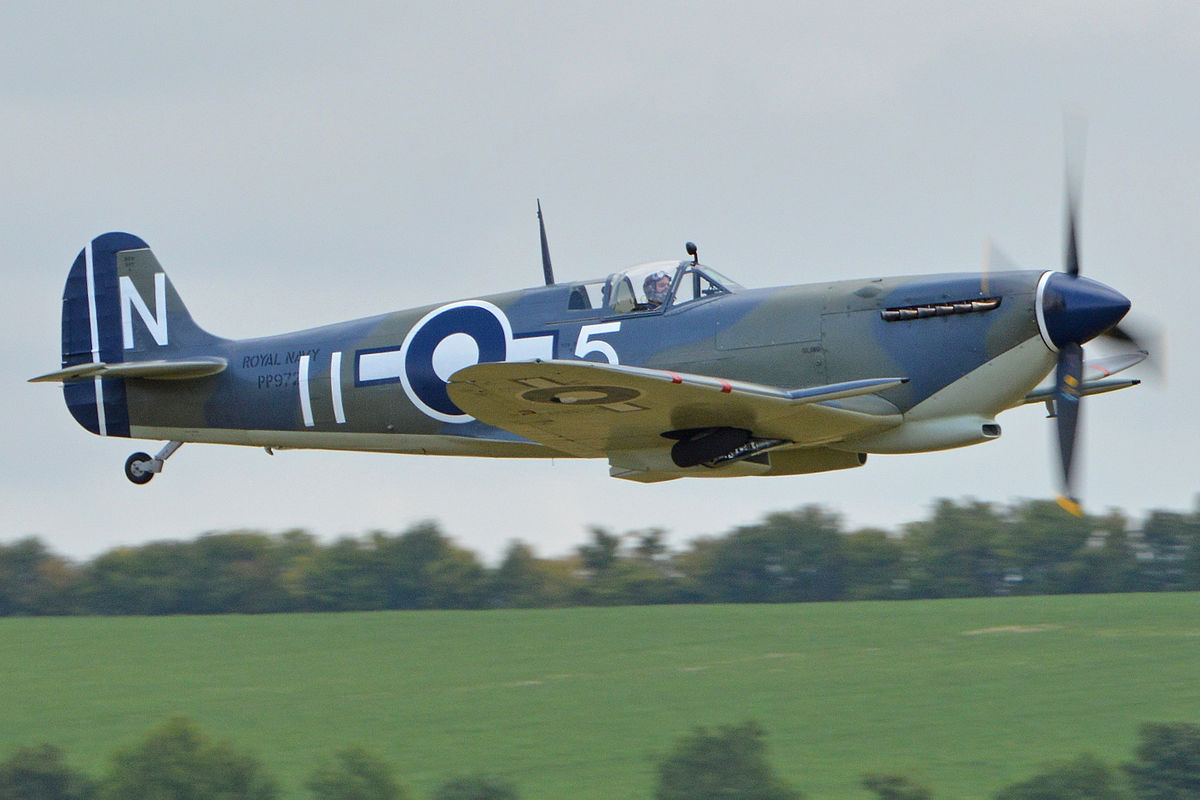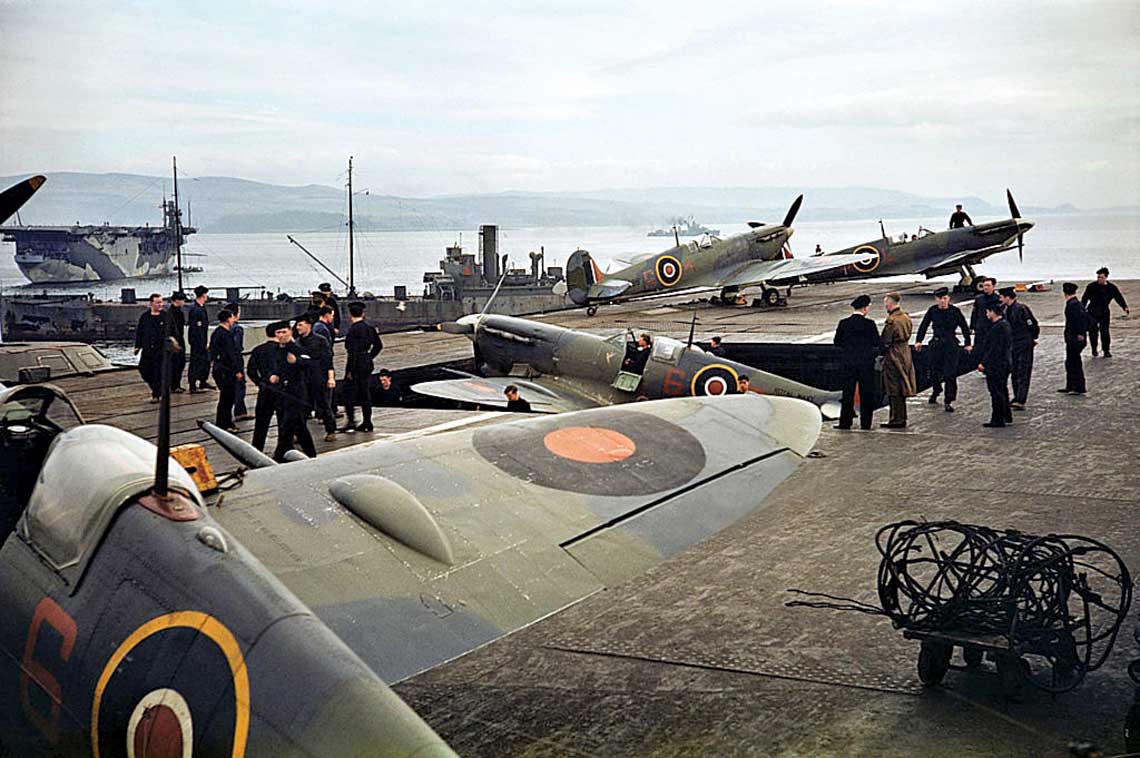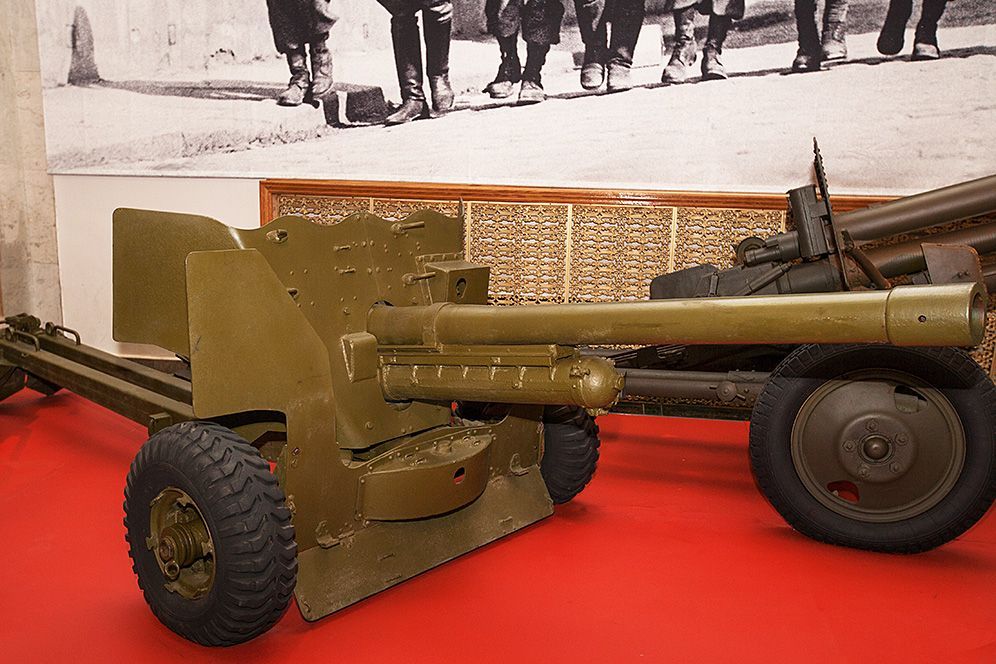
Supermarine Seafire ch.1

NAS 899 aboard HMS Indomitable in preparation for Operation Husky; Scapa Flow, June 1943. Noteworthy is the enlarged elevator, which allowed the ship to take on board aircraft with non-folding wings.
The Seafire was one of several fighter types used with more or less success by the FAA (Fleet Air Arm) aboard Royal Navy aircraft carriers during World War II. History has judged him very critically. Is it deserved?
The assessment of the Seafire was undoubtedly influenced by the fact that no other FAA fighter was expected to be as successful as the aircraft, which in the original version was a simple adaptation of the legendary Spitfire. The merits and fame of the latter, especially after the Battle of Britain in 1940, were so great that the Seafire seemed "doomed to succeed". However, over time, it turned out that the aircraft, which is an excellent ground-based interceptor, is of little use for service on aircraft carriers, since its design simply did not take into account the specific requirements for airborne fighters. First things first…
Learn from mistakes
The British Navy went to war with a misconception about the use of its airborne aircraft. Royal Navy aircraft carriers had to operate far enough from enemy airfields to be out of range of most of their aircraft. Rather, FAA fighters were expected to intercept flying boats, or perhaps long-range reconnaissance aircraft, that would try to track the movements of Royal Navy ships.
It seemed that when faced with such an adversary, high maximum speed, maneuverability or high rate of climb was an unnecessary luxury. Aircraft were used with longer flight times, which allowed continuous patrols for several hours in close proximity to the ships. However, it was recognized that a navigator was necessary, burdening the fighter with a second crew member (only American and Japanese experience in this regard convinced the British that an airborne fighter was capable of navigating alone). As if that weren't enough, two more completely erroneous concepts were implemented.
According to the first, the effect of which was the Blackburn Roc aircraft, the fighter did not need straight-line armament, since a turret mounted on its stern would provide great opportunities2. According to the second concept, which resulted in the Blackburn Skua aircraft, the airborne fighter could be "universal", that is, it could also perform the role of a dive bomber.
Both of these types of aircraft were completely unsuccessful as fighters, mainly due to their poor performance - in the case of the Skua, the result of too many compromises3. The Admiralty only realized this when, on 26 September 1939, nine Skua from the aircraft carrier Ark Royal collided with three German Dornier Do 18 boats over the North Sea. And when the following year (June 18, 13) during the Norwegian campaign, Skua ventured over Trondheim to bomb the Scharnhorst battleship and stumbled upon Luftwaffe fighters there, German pilots shot down eight of them without loss.
Churchill's intervention
The need to quickly find a replacement for the Roc and Skua aircraft resulted in the adaptation of the P.4 / 34 prototype light dive bomber, rejected by the RAF, for the needs of the FAA. Thus, the Fairey Fulmar was born. It had a solid construction (which is especially desirable in flight service) and an excellent flight duration for fighters of that time (more than four hours). In addition, he was armed with eight straight-line machine guns with twice the ammo capacity of the Hurricane, thanks to which he could even conduct several skirmishes in one long patrol. However, it was a two-seat fighter based on the Fairey Battle light bomber design, so top speed, ceiling, maneuverability and rate of climb were also no match for single-seat fighters.
With this in mind, as early as December 1939, the FAA approached Supermarine with a request that the Spitfire be adapted for airborne service. Then, in February 1940, the Admiralty applied to the Air Ministry for permission to build 50 "naval" Spitfires. However, the time for this was extremely unfortunate. The war continued and the RAF could not afford to limit the supply of its best fighter. Meanwhile, it was estimated that the development and production of these 50 fighters for the FAA, due to their more complex design (folded wings), would reduce the production of Spitfires by as much as 200 copies. Finally, at the end of March 1940, Winston Churchill, then First Lord of the Admiralty, was forced to resign.
from this project.
By the time the Fulmarians entered service in the spring of 1940, the FAA had received a number of Sea Gladiator biplane fighters. However, they, like their equally outdated land-based prototype, had little combat potential. The position of the airborne aircraft of the Royal Navy improved significantly with the adoption of the "Martlets", as the British originally called the American-made Grumman F4F Wildcat fighters, and in the middle of 1941 the "sea" version of the Hurricane. However, the FAA did not stop trying to get "their" Spitfire.

The first Seafire - Mk IB (BL676) - photographed in April 1942.
Sifire IB
This need of the Royal Navy to have a fast fighter on board proved, though too late, but by all means justified. During operations in the Mediterranean, the British fleet was within range of bombers and torpedo bombers of the Luftwaffe and Regia Aeronautica, which the FAA fighters of that time often could not even catch up with!
Finally, in the fall of 1941, the Admiralty traded 250 Spitfires for the Air Ministry, including 48 in the VB variant and 202 VC. In January 1942, the first modified Spitfire Mk VB (BL676), equipped with a ventral hook for engaging the brake lines and crane hooks for lifting the aircraft on board, made a series of test takeoffs and landings aboard the Illustrias. an aircraft carrier at anchor in the Firth of Clyde off the coast of Scotland. The new aircraft was named "Seafire", abbreviated "Sea Spitfire" to avoid alliterative dissonance.
The very first on-board tests revealed the obvious drawback of the Seafire - poor visibility from the cockpit forward. This was caused by the aircraft's relatively long nose covering the ship's deck, and by the DLCO4 in a "three-point" landing (simultaneous contact of all three landing gear wheels). With the correct landing approach, the pilot did not see the deck for the last 50 meters - if he did, it meant that the tail of the aircraft was too high and the hook would not catch the rope. For this reason, pilots were advised to perform a continuous curved landing approach. By the way, the FAA pilots later “tamed” much larger and heavier Vought F4U Corsair fighters in the same way, which the Americans could not cope with.
In addition to installing landing and lifting hooks (and strengthening the airframe in these places), the conversion of the Spitfire Mk VB to the Seafire Mk IB included the replacement of a radio station, as well as the installation of a state recognition system. transponder and receiver of guidance signals from Type 72 beacons installed on aircraft carriers of the Royal Navy. As a result of this alteration, the curb weight of the aircraft increased by only 5%, which, combined with increased air resistance, led to a decrease in maximum speed by 8-9 km / h. Eventually 166 Mk VB Spitfires were rebuilt for the FAA.
The first Seafire Mk IB was accepted into FAA status only on June 15, 1942. Initially, aircraft of this version, due to their age and degree of service, had to remain in training units - many of them had previously been rebuilt into a standard Mk VB from even older Mk I Spitfires! However, at the time, the Royal Navy's need for airborne fighters was so great – apart from convoys, the North African landing date (Operation Torch) was approaching – that the entire squadron of 801st NAS (Naval Air Squadron) was equipped with the Seafire Mk IB stationed on aircraft carrier Furious. The lack of folding wings and catapult attachments was not a problem, as the Furious was equipped with large T-shaped deck lifts, but the catapults were not.
A year later, when most of the new version of the Seafires were sent to cover the landings in Salerno, half a dozen old Mk IBs were taken from school squadrons. They were handed over for the needs of the 842nd US Division, stationed on the escort aircraft carrier Fencer, which covered convoys in the North Atlantic and in the USSR.
The armament of the Mk IB was the same as that of the Spitfire Mk VB: two 20 mm Hispano Mk II cannons with a 60-round drum magazine each and four 7,7 mm Browning machine guns with 350 rounds of ammunition. Under the fuselage it was possible to hang an additional fuel tank with a capacity of 136 liters. Seafire speedometers are calibrated to show speed in knots, not miles per hour.
Sapphire IIC
Simultaneously with the conversion of the Mk VB Spitfire to the Royal Navy, another Seafire variant based on the Spitfire Mk VC began production. Deliveries of the first Mk IICs began in the summer of 1942, at the same time as the first Mk IBs.
The new Seafires were not created from the reconstruction of finished aircraft, as in the case of the Mk IB, but left the shop already in the final configuration. But they did not have folding wings - they differed from the Mk IB mainly in the catapult mounts. Of course, they also had all the features of the Spitfire Mk VC - they were armored and had wings adapted for the installation of a second pair of guns (the so-called universal type C wing), with a reinforced structure for carrying bombs. For the same purpose, the Spitfire Mk VC chassis was strengthened, which proved to be a very desirable feature of the Seafire, allowing the use of ventral fuel tanks with a capacity of 205 liters.
at 1,5 o'clock.
On the other hand, the Mk IB were lighter than the Mk IIC - their curb weight was 2681 and 2768 kg, respectively. In addition, the Mk IIC is equipped with an anti-resistance catapult. Since both aircraft had the same power plant (Rolls-Royce Merlin 45/46), the latter had the worst performance. At sea level, the Seafire Mk IB had a top speed of 475 km/h, while the Mk IIC only reached 451 km/h. A similar decrease was seen in the rate of climb - 823 m and 686 m per minute, respectively. While the Mk IB could reach a height of 6096 meters in eight minutes, the Mk IIC took more than ten.
This noticeable drop in performance led the Admiralty to reluctantly abandon the possibility of retrofitting the Mk IIC with a second pair of guns. A kind of compensation was the later introduction of feeding the guns from the tape, and not from the drum, which doubled the ammunition load for them. Over time, the Seafire Mk IB and IIC engines increased their maximum boost pressure to 1,13 atm, slightly increasing speed in level flight and climb.
By the way, from the ejection nozzles, which reduced the maximum speed of the Mk IIC by as much as 11 km / h, at first there was little sense. British aircraft carriers at that time, with the exception of the newest ones (such as Illustrious), did not have such devices, and catapults aboard American-made escort aircraft carriers (transferred to the British under a Lend-Lease agreement) were not compatible with Seafire attachments.
Attempts were made to solve the issue of reducing the raid by experimental installation of the so-called. RATOG (jet take-off device). Solid rockets were placed in pairs in containers fixed at the base of both wings.
The system turned out to be too difficult to use and risky - it is easy to imagine the consequences of firing a missile from only one side. In the end, a very simple solution was chosen. The Seafire, like the Spitfire, had only two underwing flap positions: deflected (almost at a right angle) for landing or retracted. In order to set them at the optimal take-off angle of 18 degrees, wooden wedges were inserted between the flaps and the wing, which the pilot threw into the sea after takeoff, lowering the flaps for a moment.
Seafire L.IIC and LR.IIC
The combat debut of the Sifires, which took place in the Mediterranean at the end of 1942, proved the urgent need to improve their performance. The Junkers Ju 88, the most formidable enemy of the Royal Navy, had almost the same maximum speed (470 km/h) as the Seafire Mk IB and was definitely faster than the Mk IIC. Worse, the design of the Spitfire (and hence the Seafire) was so flexible that repeated "hard" landings on an aircraft carrier caused deformation of the engine cowling panels and covers of ammunition racks, technical hatches, etc. air resistance, which leads to a further decrease in performance.
Sea lights with the Merlin 45 engine developed a maximum speed of 5902 m, and ships with the Merlin 46 engine at an altitude of 6096 m. At the same time, most of the naval air battles were conducted below 3000 m. For this reason, the Admiralty became interested in the Merlin 32 engine, which develops maximum power at altitude of 1942 m. up to 1,27 HP To make full use of it, a four-bladed propeller was installed.
The effect was impressive. The new Seafire, designated L.IIC, could reach speeds of 508 km/h at sea level. Having risen at a speed of 1006 m per minute, in just 1524 minutes 1,7 m was reached. At this optimal height for him, he could accelerate to 539 km / h. At full throttle, the rate of climb increased to 1402 meters per minute. In addition, the L.IIC had a shorter coast down even without flaps extended than previous Seafires with 18 degree flaps extended. Therefore, the decision was made to replace all Merlin 46 engines in the Seafire Mk IIC with the Merlin 32. The transition to the L.IIC standard began in early March 1943. The first squadron (807th NAS) received a set of aircraft of the new version in mid-May.
Following the example of the RAF, which removed the wingtips of some of their Mk VC Spitfires, a number of L.IIC Seafires were modified in the same way. The advantage of this solution was a definitely higher roll speed and a slightly higher (by 8 km/h) speed in level flight. On the other hand, aircraft with wingtips removed, especially those with full ammunition and an external fuel tank, were more resistant to steering and less stable in the air, which was simply more tiring to fly. Since this modification could easily be performed by ground crew, the decision to fly with or without tips was left to the discretion of squadron leaders.
A total of 372 Seafire IIC and L.IIC aircraft were built - Vickers-Armstrong (Supermarine) produced 262 units and Westland Aircraft 110 units. Standard IICs remained in service until March 1944, and standard IICs until the end of that year. About 30 Seafire L.IICs were upgraded with two F.24 cameras (mounted in the fuselage, one vertical, the other diagonally), creating a photo reconnaissance version, designated LR.IIC.
